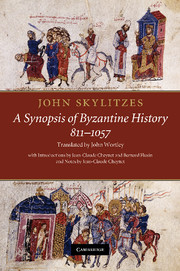Book contents
- Frontmatter
- Contents
- The English translator’s Preface
- Introduction
- Re-writing history: John Skylitzes’ Synopsis historion
- Foreword
- Chapter 1 Michael I Rangabe, the Kouropalates [811–813]
- Chapter 2 Leo V the Armenian [813–820]
- Chapter 3 Michael II the Stammerer [820–829]
- Chapter 4 Theophilos [829–842]
- Chapter 5 Michael III, the son of Theophilos [842–867], and his mother Theodora [842–862]
- Chapter 6 Basil I Kephalas, the Macedonian [867–886]
- Chapter 7 Leo VI the Philosopher (the Wise) [886–912]
- Chapter 8 Alexander [912–913]
- Chapter 9 Constantine VII, Porphyrogennetos [913–959]
- Chapter 10 Romanos I Lekapenos [919–944]
- Chapter 11 Constantine VII [944–959]
- Chapter 12 Romanos II the Younger [959–963]
- Chapter 13 Basil II Bulgaroktonos and Constantine VIII [976–1025]
- Chapter 14 Nikephoros II Phokas [963–969]
- Chapter 15 John I Tzimiskes [969–976]
- Chapter 16 Basil II and Constantine VIII bis [976–1025]
- Chapter 17 Constantine VIII [1025–1028]
- Chapter 18 Romanos III Argyros [1028–1034]
- Chapter 19 Michael IV the Paphlagonian [1034–1041]
- Chapter 20 Michael V Kalaphates [1041–1042]
- Chapter 21 Constantine IX Monomachos [1042–1055]
- Chapter 22 Theodora [1055–1056]
- Chapter 23 Michael VI the Elder/Stratiotikos [1056–1057]
- Glossary
- Bibliography
- Index
- References
Chapter 11 - Constantine VII [944–959]
Published online by Cambridge University Press: 05 July 2014
- Frontmatter
- Contents
- The English translator’s Preface
- Introduction
- Re-writing history: John Skylitzes’ Synopsis historion
- Foreword
- Chapter 1 Michael I Rangabe, the Kouropalates [811–813]
- Chapter 2 Leo V the Armenian [813–820]
- Chapter 3 Michael II the Stammerer [820–829]
- Chapter 4 Theophilos [829–842]
- Chapter 5 Michael III, the son of Theophilos [842–867], and his mother Theodora [842–862]
- Chapter 6 Basil I Kephalas, the Macedonian [867–886]
- Chapter 7 Leo VI the Philosopher (the Wise) [886–912]
- Chapter 8 Alexander [912–913]
- Chapter 9 Constantine VII, Porphyrogennetos [913–959]
- Chapter 10 Romanos I Lekapenos [919–944]
- Chapter 11 Constantine VII [944–959]
- Chapter 12 Romanos II the Younger [959–963]
- Chapter 13 Basil II Bulgaroktonos and Constantine VIII [976–1025]
- Chapter 14 Nikephoros II Phokas [963–969]
- Chapter 15 John I Tzimiskes [969–976]
- Chapter 16 Basil II and Constantine VIII bis [976–1025]
- Chapter 17 Constantine VIII [1025–1028]
- Chapter 18 Romanos III Argyros [1028–1034]
- Chapter 19 Michael IV the Paphlagonian [1034–1041]
- Chapter 20 Michael V Kalaphates [1041–1042]
- Chapter 21 Constantine IX Monomachos [1042–1055]
- Chapter 22 Theodora [1055–1056]
- Chapter 23 Michael VI the Elder/Stratiotikos [1056–1057]
- Glossary
- Bibliography
- Index
- References
Summary
As the emperor Constantine had been left an orphan in very early childhood, affairs of state were conducted by Zoe his mother and the regents whom we listed above. Constantine the parakoimomenos exercised considerable influence over the empress while the magister Leo Phokas, domestic of the scholai for the east, was his brother-in-law, having married his sister. Thus Constantine effectively held all the reins of state and could direct it wherever he wished. Night and day he searched for a way of getting rid of [the emperor] Constantine and of transferring the imperial office to his own brother-in-law. When Theodore, the tutor of the porphyrogennetos, realised this, he endeavoured (as we said above) to appropriate the elder Romanos who was then droungarios of the fleet and bring him into the palace in the hope that he would be the protector and defender of the emperor. Romanos was brought in and, little by little, gained possession of all the levers of power. Not content with the powers assigned to him though, he broke his oaths (and he had bound himself with the most awesome oaths that he would never aspire to be emperor) and proclaimed himself emperor. It was the porphyrogennetos who placed the diadem on his brow, willingly to all appearances, ‘but with a most unwilling heart’ to cite Homer. And it was not only himself but also Christopher, his son, whom Romanos proclaimed emperor, a short time after. He let some more time go by and then proclaimed his sons Stephen and Constantine. Now, although he was proclaimed emperor, he did not like the ranking: it displeased him to be in second place. So he expelled the tutor and any others who seemed to be opposed to him, then he proclaimed himself first emperor and took over the administration of all [234] the affairs of state. His sons ranked after him and Constantine [VII] came last of all. By now Constantine had only the appearance and name of emperor, for he was deprived of all the privileges; therefore his constant endeavour and most fervent wish was to get rid of the usurpers and assume his father’s supreme command.
- Type
- Chapter
- Information
- John Skylitzes: A Synopsis of Byzantine History, 811–1057Translation and Notes, pp. 225 - 238Publisher: Cambridge University PressPrint publication year: 2010

